#oxyvisualanalysis
Explore tagged Tumblr posts
Text
Reading Notes 6: Freud to Lacan to Fanon
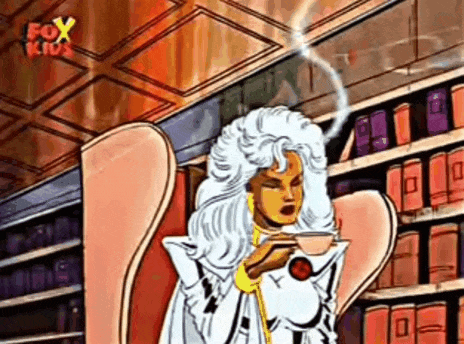
We look to Sigmund Freud’s “The Uncanny,” Jacques Lacan’s “The Mirror Stage as Formative of the Function of the I,” and Frantz Fanon’s “The Negro and Psychopathology” for our inquiry into the functions of psychoanalysis and subjectivity when examining visual texts.
Why do people call an experience or event uncanny, and what makes an occurrence that appears to be uncanny but is not uncanny?
What is the relation of personal neurosis to social passions?
In what ways are oppressed and marginalized viewers alienated when they are not or rarely represented?
@theuncannyprofessoro
18 notes
·
View notes
Text
Discussion Leader Panel Presentation - Race and Representation
youtube
While the song “Can’t Hold Us Down” by Christina Aguilera1 is mostly about female empowerment and resisting gender stereotypes, the music video conveys even more, with stark imagery of a community that is made up primarily of people of color. The intersectionality that the video possesses is key to understanding its message. In Stuart Hall’s essay “What is this ‘black’ in black popular culture?2,” he introduces his idea that the “Black” in Black popular culture is not a set idea, rather it is a fluid conversation of Blackness. In his words, “What we are talking about is the struggle over cultural hegemony, which is these days waged as much in popular culture as anywhere else”3. While, as I stated earlier, on the surface this video is about what it means to be a woman, its underlying themes are of race and representation, which is the real battle being fought. This intersectionality is still key to Hall’s philosophy. As he says, “We are always in negotiation, not with a single set of oppositions that place us always in the same relation to others, but with a series of different positionalities”4. Aguilera’s exploration of themes of sexuality while using the backdrop of a primarily people-of-color community is this video’s way of continuing the conversation about what it means to be “Black”, or in the video’s case, simply “other”. “The Other” is a concept Edouard Edward Said introduces in his seminal book Orientalism5. In the context of the Orient, better known as Asia, he states that “The Orient is not only adjacent to Europe; it is also the place of Europe’s greatest and richest and oldest colonies, the source of its civilizations and languages, its cultural contestant, and one of its deepest and most recurring images of the other”6. He goes on to say that Europe sees Asia as “its contrasting image, idea, personality, experience”7, yet it is “an integral of European material civilization and culture”7. While Aguilera’s video does not explicitly speak about Orientalism, some key themes are very present. In Orientalism, Said refers to the way Asia is perceived as “‘a place of romance, exotic beings, haunting memories and landscapes, remarkable experiences”6. Essentially, Orientalism places emphasis on the mystification of Asian culture, through the power of European colonialism. The environment Aguilera’s video is set in is extremely colorful, and, as previously mentioned, mostly populated with people of color. Most of the very few white people in this video appear in the beginning, shown throwing milk into the street below. This can be seen as a representation of Orientalist themes. The white people are placed above the people of color who populate the streets below, and throw milk onto them, which can represent the Orientalist turn of imposing Euro-centricity on the culture of those colonized and disenfranchised.
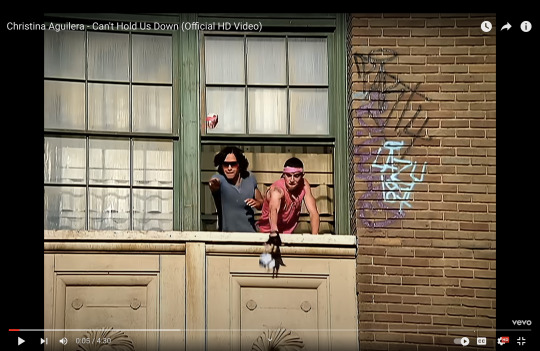
Of course, the question must be asked, is this music video an authentic representation of the culture and community that it’s presenting to us? In their book Unthinking Eurocentrism8, Ella Shohat and Robert Stam consider the way that race and representation exist in the media. Under the section “Writing Hollywood And Race” in the chapter “Stereotype, Realism And The Struggle Over Representation,” they argue that there is an important distinction between media image and social reality. They use the documentary Color Adjustment to help their argument, stating that “Color Adjustment underlines this contrast between media image and social reality by suggestively juxtaposing sitcom episodes with documentary street footage”9. I’d like to pose the thought that perhaps Aguilera’s video would fall under the category of sitcom in this comparison, at least when it comes to the ideas of race and representation. Aguilera, who is of Ecuadorian, German, Irish, Welsh, and Dutch descent, did not grow up in people of color dominated areas of New York. She lived in Wexford, PA for most of her adolescence, a town in a majority-white county. This music video may feel inauthentic to many because it may not be authentic to Aguilera’s experiences. Which brings me to Kendrick Lamar
youtube
Kendrick Lamar grew up in Compton, CA, at a time when the city’s high crime rates were national news, due to the prominence of gangster rap groups like NWA. The music video for his song “i”10 showcases this environment prominently. From the cars to the police uniforms, the video harkens back to a time when Kendrick was growing up in South Central Los Angeles. In my estimation, Kendrick Lamar’s video represents more of the “documentary footage” that Shohat and Stam mentioned in their comparison with media image and social reality. Aguilera’s video can be felt as inauthentic because it feels like a sitcom, not in a comedic way but in a matter of faux reality. Kendrick’s video feels like a documentary because of its groundedness in his childhood and the experiences of his city. It should be noted that Aguilera appears to darken her skin in her video. As previously stated, Hall believes that popular culture is a place where the concept of “Black” is able to be conversed about. Kendrick, in his music video for “i”, is able to redefine “Blackness” on his own terms. He presents different depictions of Black characters in every moment. One moment that shows great contrast of character and incredible conversation in his own mind on the topic of “Blackness” comes at the 2:20 mark in the video for “i”11.

Kendrick walks past a house, on the front porch of which a man yells at a woman; presumably they are in a relationship. In this very same moment, two Black children, one boy and one girl, run by, playing together, juxtaposing the depiction of adult negativity behind them. There are many things that can be interpreted from this shot, which perhaps even greater lends itself to the argument that it is more “documentary footage”. The perceived authenticity of Kendrick Lamar’s “i” video thus lends itself to a challenge of Orientalist ideals. While the video does show White police officers arresting a Black man at 1:4312, seemingly exerting that idea of power over “the other” that Orientalism is built so much upon, it is immediately followed by Kendrick and his crew of dancers/partygoers weaving through the group of cops with numbers that far outweigh what the cops possess, thus re-establishing power over themselves.

Works Cited
1Aguilera, Christina. “Christina Aguilera - Can’t Hold Us Down (Official HD Video).” YouTube, November 18, 2009. https://www.youtube.com/watch?v=dg8QgUIKXHw&t=196s.
2Hall, Stuart. “What Is This ‘Black’ in Black Popular Culture?” Essay. In Critical Dialogues in Cultural Studies. London, United Kingdom: Routledge, 1996.
3Hall. “What Is This ‘Black’ in Black Popular Culture?”, 471
4Hall. “What Is This ‘Black’ in Black Popular Culture?”, 476
5Said, Edward. “Introduction.” Essay. In Orientalism. London, United Kingdom: Routledge, 1978.
6Said. Orientalism, 9
7Said. Orientalism, 10
8Shohat, Ella, and Robert Stam. “Stereotype, Realism And The Struggle Over Representation.” Essay. In Unthinking Eurocentrism. New York, NY: Routledge, 1994.
9Shohat and Stam. “Stereotype, Realism And The Struggle Over Representation”, 198
10Lamar, Kendrick. “Kendrick Lamar - i (Official Video).” YouTube, November 4, 2014. https://www.youtube.com/watch?v=8aShfolR6w8.
11Lamar. “i”, 2:20
12Lamar. “i”, 1:43
Discussion Questions
Can the darkening of one’s skin make the work feel more authentic, and when might this backfire?
Does either video engage in stereotype, and if so, does it detract from the video or benefit it?
Is fair to compare the music videos for these songs, though the lyrics of the songs convey such different messages, and can a music video change a son’s message?
14 notes
·
View notes
Text
@theuncannyprofessoro
14 notes
·
View notes
Text
Intro Vid
16 notes
·
View notes
Text
Explorations of Semiotics and Structuralism in 'Take On Me' and 'She Likes a Boy'
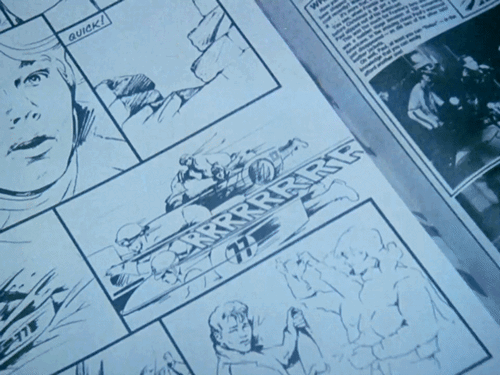
Take On Me
‘Take On Me’ details the epic love story of a man chasing after his dear love, culminating in a moment of passion when the two finally meet, only for the man to leave again. It’s a cute story with tinges of melancholy thanks to the yearning nature and the idea of ‘right person, wrong time.’ Right? Well, that’s what the music video would have you think. Simply looking at the lyrics, which tell of a man consistently pursuing a woman, believing her to be his one true love, trend more towards stalker behavior. It seems this piece of iconic culture is another in a long line of problematic romance that is portrayed as perfectly normal and, in fact, romantic. But why? The answer lies in the signs.
According to Saussure, the sign is made up of a signifier—the sound-image—and a signified—the concept.[1] Here, the signifier is the lyrics that are sung and the signified is ‘love’ or ‘romantic relationships.’ For ‘Take On Me,’ the signified and signifier are unified by the sign that is created during the synthesis of the two: the music video. The concept described in the lyrics is visualized in the music video through a fantastical, reality-breaking story where the narrator of the song pulls the girl he loves into the pages he exists within, then eventually finds her in the real world after she leaves the 2D world. Due to the signifiers utilized in the music video, the audience interprets the entire song and its concept as a positive representation of love rather than the problematic stalker-coded story that is so prevalent in media.
The signifiers in the music video—the sign—point to the mythologization of ‘Take On Me,’ as Barthes describes a myth as a sign becoming a signifier of something else.[2] Barthes also says that mythical signification is “never arbitrary”,[3] so what does that tell us about ‘Take On Me?’ If the reason behind the music video misconstruing the concept and lyrics to create the image of a healthy romantic relationship is motivated by something, what exactly clues us into the motivation?
Metz dictates in “Some Points in the Semiotics of Cinema” that because of cultural or specialized codes that are embedded in our society’s collective understanding, some visuals have implications for the viewer and will be interpreted in a certain way before the cinematic language can tell the viewer what the connotation—and the related denotation—should be.[4] The ‘Take On Me’ music video draws on romance tropes, settings and characters that are extremely prevalent in our cultural understanding of the concept of ‘love’ or ‘romantic relationships’ in a way that evokes a feeling of positive association with the sign. The aesthetic of the diner, a classic date spot, and the plot thread about the straight-laced female love interest being—literally—pulled into the dangerous world of the bad boy are tropes that generate an association with love and romance such that the audience has an idea of what the music video is about before they even watch all of it.

This positive association prevents the audience from interpreting the sign through its signifier, the lyrics. The connotation that the sign evokes through the mythologization the music video participates in is one of a happily ever after romance, but the denotation—the relationship between the concept of love and the lyrics that describe stalker-ish behavior—is one that reveals that the love story between the narrator of the song and the love interest is maybe not so cute.
She Likes a Boy
‘She Likes a Boy’ has a similar concept to ‘Take On Me’ in that they both focus on love and the romantic relationships that ensue from people being in love. But ‘She Likes a Boy’ focuses on the unrequited love, one that is born from a queer person falling for their straight friend—ironically, a trope that has emerged within the canon of queer storytelling. At least, this trope is what the music video posits the song to be about; again, the lyrics and associated concept can be interpreted differently without the music video as a sign to guide the audience towards a particular understanding.
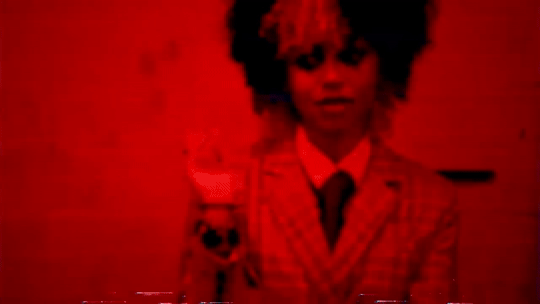
The song was initially released as a single on January 12 in 2024 (though the artist Nxdia released a snippet of the song on TikTok in late 2023), with the music video not arriving until nearly a month later on February 14. This gap gave listeners ample time to interpret the lyrics as they saw fit. Several interpretations match up to the music video’s representation of the signified and signifier as a whole, with lesbians and others that like women lamenting the pain of falling for a straight person, while other videos touch on the insecurity that butch and masc lesbians feel due to presenting more masculine. But due to the “correct” interpretation not being laid out by the music video, other queer people were able to make meaning out of the signifier and signified that completely deviated from the original narrative.
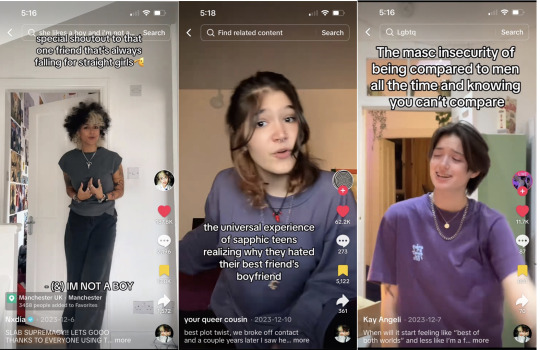
Some transgender men felt they could relate to the song as it described the gender dysphoria they experience on a day to day basis. Hence: how could a girl like me if I’m not a ‘real boy?’ Nonbinary and gender non-conforming folk might interpret the lyrics ‘I’m not a boy’ as ‘I’m not a boy but I’m not a girl either.’ That interpretation encapsulates the experience of people who don’t fall into the categories of the gender binary and as a result don’t know who will love them for themselves. These interpretations were a result of the signifier and signified not being associated with a specific sign due to the music video not guiding viewers and listeners into that line of thinking. Saussure would call this a result of the “arbitrary nature” of the sign, with value and meaning being assigned to signifier/signified relationships nearly at random.[5]
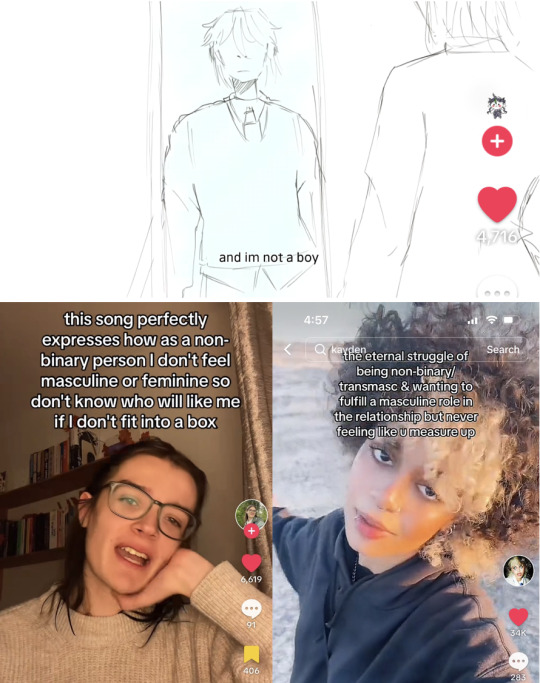
The random nature of the sign’s meaning is at odds with the values assigned to the signified and signifiers within the music video itself. The myth of ‘She Likes a Boy’ is extremely apparent when applying Barthes’ conclusions from “The Great Family of Man.” In that particular essay, Barthes describes how the idealization of our history decreases its value; our past is relegated to something so poetic that it hardly matches up to our current reality.[6] The ‘ideal past’ becomes a signifier for what our life should be, but our actual lives—the signified—isn’t represented by that idealized version.
Something like this happens in ‘She Likes a Boy.’ Nxdia compares themselves to the boy their friend likes, trying to show that there is so little difference between them. The cinematography of the music video also compares the two, with parallel shots used to compare Nxdia and the boy that the girl likes. By highlighting the comparisons, the music video signals to the viewer the idealized reality that Nxdia wants to live in, one where by being comparable to a boy, the girl they like will like them back. But the cinematography also uses lighting in a clever way to distinguish between the idealized reality and the actual life that Nxdia is living. It shows Nxdia playing into the ideal heteronormative romance despite being a queer person, which further complicates the concept of 'love' and 'romantic relationships' in the context of the song.
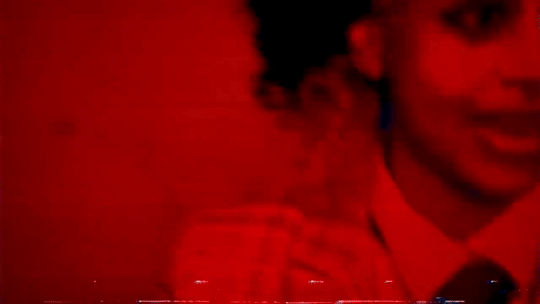
The disparity between signifier and signified is similar to the differing interpretations of the sign by listeners before the music video was released. It seems Saussure’s postulation about the arbitrary nature of the sign was entirely correct; the meaning we assign to the sign is entirely dependent on the associations we have with the sign, its signifier and its signified.[7] From this, we can deduce that there is no correct way to interpret a sign, unless the sign has become a myth in its own right.
Discussion Questions:
How does the presence of two worlds (the world in the drawing and the real world) in 'Take On Me' create layers of myth?
Why might the creators of the 'Take On Me' music video want the love story to be perceived as its connotation (happy and healthy) rather than as its denotation (the stalker behavior lyrics)?
Does the arbitrary nature of the sign add to or subtract from the meaning different listeners assigned to the 'She Likes a Boy' music video?
Is there an inherent 'correctness' to the interpretation of the lyrics to 'She Likes a Boy' based on the fact that the music video outlines one such interpretation?
Works Cited:
Barthes, Roland. “Myth Today” and “The Great Family of Man.” In Mythologies, 100-102 and 106-126. Translated by Annette Lavers. New York: The Noonday Press, 1957.
Metz, Christian. “Some Points in the Semiotics of Cinema.” In Film Theory and Criticism, 65-77. Edited by Leo Braudy and Marshall Cohen. New York/Oxford: Oxford University Press, 2009.
Saussure, Ferdinand de. Course in General Linguistics. Edited by Charles Bally, Albert Sechehaye and Albert Rledlinger. Translated by Wade Baskin. New York/Toronto/London: McGraw-Hill Book Company, 1916.
[1] Saussure
[2] Barthes, Myth Today
[3] Barthes, Myth Today
[4] Metz
[5] Saussure
[6] Barthes, The Great History of Man
[7] Saussure
@theuncannyprofessoro
11 notes
·
View notes
Text
my visual introduction for class
15 notes
·
View notes
Text
Panel Presentation: "Telephone" and "Thot Shit"
youtube
“TELEPHONE” LADY GAGA & BEYONCE
In Lady Gaga’s “Telephone” (ft. Beyonce) music video, she centers two women criminals, half of the video taking place at a women's prison and the other half following the homicide the women (played by Gaga and Beyonce) set out to commit. The first striking thing about the video is the immediate use of women’s bodies. All the women in the prison are wearing revealing outfits, even the women security guards. As Gaga walks down the cells, the fellow prisoners (all female-presenting) hoot and holler and as character is thrown into her cell, the guards promptly rip off her clothes. This is an example of the use of a woman’s body that is not centering the male gaze. While a male gaze still may derive pleasure from the revealing costumes in the video, these characters are not necessarily designed to be seen as sexy by the male spectator. In Laura Mulvey’s “Visual Pleasure and Narrative Cinema,” she writes that media depictions of women in a patriarchal culture stand as a signifier for the male other - meaning that women characters are present to engage with the male fantasy (1). While most of the women in the music video are partially nude or in revealing costumes, they are not doing so in a sexual nature. Their nudity and sexuality isn’t aiming to please men but to claim their own sexual identity. Mulvey also touches on how women’s bodies in “alternative cinema” can be also a radical or political aspect that challenges the basic assumptions of mainstream media, instead of just being objects for pleasure (2). Women’s bodies are shown in “Telephone” in different ways than usual music videos – there is more of a diversity in beauty and a roughness to them – these bodies are asking to be looked at.

In hooks’ “The Oppositional Gaze: Black Female Spectators,” she writes about the “right to gaze.” Specifically, she references: “the politics of slavery, of racialized power relations, were such that the slaves were denied their right to gaze” (3). In these racialized power relations, she writes that Black people were not permitted to engage in the same freedom of watching, entertainment, or deriving pleasure from what they were seeing. This structure ultimately permeates to this day, as hooks writes that of the Black women she spoke to, none were excited to attend the movie theaters, knowing they would not be properly represented (4). How “Telephone” works in contrast with this trend is allowing spectators to look at and derive pleasure from the woman’s body. The idea of the oppositional gaze is a major part of the video because it challenges the ideas of dominant images that women must conform to. The video’s way of resisting the hegemonic gaze was to place the power into the hands of the women characters and for their bodies and strength to be shown without comparing it to that of a male character. hooks references Manthia Diawara to talk about the power of the spectator: “Every narration places the spectator in a position of agency; and race, class and sexual relations influence the way in which this subjecthood is filled by the spectator” (4) (309). Each person, specifically women, watching this music video could feel a sense of agency after experiencing women characters having power over their own bodies.

On the topic of bodies, the music video employs a semi-diverse cast of women in the video (the majority of women in the video are still white). Specifically, a lot of the women have stark differences about them like ethnicities, age, or sexual identity. In Audre Lorde’s “Age, Race, Class, and Sex: Women Redefining Difference,” she writes that emphasizing differences is usually taught to be bad or ignored, “or to view them as causes for separation and suspicion rather than as forces for change” (5). In “Telephone,” the differences between these women in prison or Beyonce and Gaga as criminals is distinctly outlined. It is unclear with what Gaga and the writers of the video were trying to accomplish with the “outsider-ness” of the characters in the video – if they were trying to make them look bad or powerful –but one could argue that these women could fit into the archetype of rebels, not caring about society’s rules for them, and that would empower the viewer. It could also be argued that these women are represented by a stereotype of women in prison: violent, erratic, and their homosexuality coming off as predatory and creepy. Mulvey references those who have stood “outside the circle of this society’s definition of acceptable women; those of us who have been forged in the crucibles of difference” (6). “Telephone” puts examples in its video of women on the “margins of society,” but their purpose of being there is unclear to the viewer.

Questions:
Do you think that the other women in the video are meant to be powerful or other-ed, just perpetuating a stereotype?
Do you think “Telephone” practices using the “oppositional gaze”?
How do you think the sexual nature of woman characters in the video differs from other media depictions we have seen?
youtube
“THOT SHIT” MEGAN THEE STALLION
At the beginning of the “Thot Shit” music video, the character of the senator is shown leaving a hate comment on one of Megan’s former music videos (“Body”). When he receives a phone call from Megan she tells him “the women that you are trying to step on are the women you depend on. They treat your diseases, they cook your meals, they haul your trash, they drive your ambulances, they guard you while you sleep. They control every part of your life. Do not fuck with them.” This quote is then the theme for the rest of the video. As the senator tries to escape, Megan and her dancers have taken over every occupation and are dancing in his face. Something interesting in this video is the idea of scopophilia that the senator is taking part in. While he is at first closing his blinds and leaving hate comments before gazing, now Megan and her dancers are forcing him to look, owning their image. Mulvey writes about scopophilia in media/cinema, especially tasteful/pleasurable looking (7). While so much of scopophilia in mainstream media is about privacy and what’s “implied,” it could be argued that Megan is subverting the narrative by using her body and her dancers’ bodies freely and without concerns of what is “forbidden.” It could be seen as an act of agency.
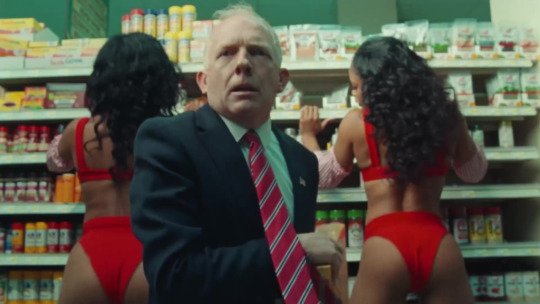
hooks herself may argue that “Thot Shit” is an example of Black women having that sense of agency – the Black women throughout the video have multiple careers while also having the freedom of sexuality. She writes: “Spaces of agency exist for Black people, wherein we can both interrogate the gaze of the Other but also look back, and at one another, naming what we see” (8). This quote encapsulates “Thot Shit” perfectly: a place that Black people can exist freely while also interrogating the gaze of the other. The music video is special because it is a way that Megan celebrates Black women but also the integral part that Black women play in society. They are portrayed as critical parts of a working society but also they dance in the video, owning their sexuality. The sexual nature of the women in the video ties to another example of hooks’ writings about Black women in film/media: the absence “that denies the 'body' of the Black female so as to perpetuate white supremacy and with it a phallocentric spectatorship where the woman to be looked at and desired is ‘white’” (9). hooks writes that too often Black women have been denied ownership and agency over their own bodies, but also the ability to be desired by white phallocentric audiences. By using the character of the senator, they show the inherent racism imposed against Black women - people criticize them but then still sexualize them. Something important to mention is Megan’s lyricism in this song - the word “thot” was coined in the hip-hop world as a derogatory term for a woman, similar to the word “slut,” “with added derision for being working class” (10). The reclamation of this term is outright powerful because it is using a word that has been weaponized against Black women for years and she repurposes it to be something powerful. This subversion in itself can be tied to the work of the oppositional gaze - taking something used to oppress Black women and flipping it to empower them instead.

Rarely in popular media as big as “Thot Shit” do viewers see something with such a clear message. Megan does include a lot of Black female empowerment throughout her music and music videos, especially through sexual agency. Lorde writes, “Black women and our children know the fabric of our lives is stitched with violence and with hatred, that there is no rest. We do not deal with it only on the picket lines, or in dark midnight alleys, or in the places where we dare to verbalize our resistance. For us, increasingly, violence weaves through the daily tissues of our living … ” (11). “Thot Shit” is a form of protesting against the dehumanization and oppression of Black women in mainstream culture. Megan consistently brings Black women into the cultural conversation when they are neglected. Her empowerment is similar to that Lorde writes of: “It is learning how to stand alone, unpopular and sometimes reviled, and how to make common cause with those others identified as outside the structures in order to define and seek a world in which we can all flourish” (12).

Questions:
What are other ways that “Thot Shit” practices scopophilia and voyeurism in nuanced ways?
How is the video different from other music videos you have seen before?
How does “Thot Shit” work in conjunction with “Telephone”?
Works cited:
Mulvey, Laura, “Visual Pleasure and Narrative Cinema” in Film Theory and Criticism, 712. (New York: Oxford University Press, 2009)
Mulvey, Laura, “Visual Pleasure and Narrative Cinema.” 712
hooks, bell, “The Oppositional gaze: Black Female Spectators” in Feminist Film Theory, 307. (New York: New York University Press, 1999)
hooks, bell “The Oppositional gaze: Black Female Spectators.” 310
Lorde, Audre. "Age, Race, Class, and Sex: Women Redefining Difference." In Sister Outsider: Essays and Speeches, 112. Berkeley, CA: Crossing Press, 2007
Lorde, Audre “Age, Race, Class and Sex: Women Redefining Difference.” (112)
Mulvey, Laura, “Visual Pleasure and Narrative Cinema.”
hooks, bell, “The Oppositional Gaze: Black Female Spectators.” 308
hooks, bell, “The Oppositional Gaze: Black Female Spectators.” 310
O’Neal, Lonnae, “I had a thot but didn’t know it was a thing” The Washington Post, March 19, 2015
Mulvey, Laura, “Visual Pleasure and Narrative Cinema.” 119
Mulvey, Laura, “Visual Pleasure and Narrative Cinema.” (112)
@theuncannyprofessoro
9 notes
·
View notes
Text
Psychoanalysis and Subjectivity
youtube
"Thriller" by Michael Jackson, released in 1983, is not just a song but an iconic cultural phenomenon, with its music video setting new standards for the industry. Directed by John Landis, the video is a mini horror film featuring Jackson as a charismatic young man transformed into a werewolf alongside his love interest, played by Ola Ray. The video showcases Jackson's unparalleled talent as a performer, with his electrifying dance moves and mesmerizing presence. Its groundbreaking special effects and narrative storytelling revolutionized the music video medium, becoming an instant classic. "Thriller" remains a timeless masterpiece, captivating audiences with its fusion of music, dance, and cinema, leaving an indelible mark on pop culture for generations to come.

Sigmund Freud's essay "The Uncanny" explores the concept of the uncanny, or the eerie feeling of discomfort or unease experienced when something seems strangely familiar yet simultaneously foreign or unsettling. Freud delves into various aspects of the uncanny, including its connection to repressed desires, the repetition of specific themes or motifs in literature and art, and its association with the return of the repressed. He ultimately suggests that the uncanny arises from the revival of primitive beliefs and fears, often related to death, castration, or the supernatural, which have been repressed into the unconscious mind. This reminds me of the entire motive of the music video, which is the aspect of death. Sigmund said, “the primitive fear of the dead is still so strong within us and always ready to come to the surface at any opportunity”(Freud, 369). Death is the main factor that spikes an uncanny feeling. Our conscious mind feels eerie when we can not define whether something is animate or inanimate. This can also be viewed through the lens of Fenon’s theory because of the transformation, performance, and cultural appropriation that happens in this video. A transformation can be seen as a metaphor for the way Black individuals have been historically portrayed as "other" or different in Western society, often associated with fear and negativity. However, it also ties into Lacan’s theory of identity and self-representation. The transformation can be interpreted as a commentary on the pressure for Black individuals to conform to white standards of beauty and behavior, which makes them see themselves differently because of social interactions.
Question: How often do you see the black community transform into something other than being black, and how much of an impact do you think it has?
youtube
"Black or White" is a groundbreaking music video by the iconic artist Michael Jackson, released in 1991. Directed by John Landis, the video captivates audiences with its innovative visual effects and powerful message of racial unity. Opening with a diverse array of faces from around the world morphing into one another, the video symbolizes the interconnectedness of humanity. Jackson's electrifying dance moves and charismatic performance are showcased against a backdrop of vibrant sets and dynamic choreography. The video's climax features a montage of people breaking through barriers, emphasizing diversity, acceptance, and equality themes. Through its striking imagery and infectious rhythm, "Black or White" remains a testament to Jackson's unparalleled talent and a timeless anthem for social change and harmony.

Frantz Fanon's essay "The Negro and Psychopathology" delves into the psychological impact of colonialism and racism on Black individuals. Fanon explores how the experience of oppression and discrimination leads to a profound sense of alienation, identity crisis, and psychological trauma among Black people. Frantz Fanon said, “The Negro recognizes the unreality of many of the beliefs that he has adopted with reference to the subjective attitude of the white man”(Fanon, 115). He implies that Black individuals have internalized certain beliefs or attitudes, possibly about themselves or about the world, that are based on the perspective or viewpoint of white people. However, they have come to recognize that some of the beliefs held by white people are not grounded in reality or are false. This means that things that are said about the black community usually is said to make them feel bad. The saddest part is that it is so engraved in our system that naturally, it just reproduces.
One aspect that correlates with Fanon's ideas is Jackson's own experience of racial identity. Throughout his life, Jackson grappled with questions of race and belonging, facing scrutiny and pressure to conform to societal expectations of blackness. His changing appearance, particularly his skin color, sparked speculation and debate about his racial identity and self-image. Fanon would likely view Jackson's transformation as a manifestation of the internalized racism prevalent in societies where lighter skin is often associated with beauty and success. This also makes me think about how his skin transformation can be perceived as uncanny. The transformation can be perceived as uncanny due to its combination of familiarity and strangeness, its psychological implications, the public reaction it elicited, and its broader cultural significance. It made him seem familiar but also unfamiliar.

This scene of the music video resonates with Jacques Lacan’s “The Mirror Stage as Formative of the Function of the I” through its exploration of identity, diversity, and unity. Just as Lacan explains that the mirror stage marks a pivotal moment in the formation of the self, the video showcases individuals from diverse ethnic backgrounds, highlighting the complexity of identity formation in a multicultural world. Lacan said, "Whence it is that the relation of the individual subject to his own images is apprehended, prior to any grasp of it by the self, in a specular relation of the organism to its reality, and that, whatever may be the degree of elaboration of the imaginary function, its mediation is necessarily situated in the intersubjective dialectic"(Lacan). This statement explains that individuals have an inherent, perhaps unconscious, relationship with their mental images or representations, which reflects their perception of reality. This relationship is influenced by interpersonal dynamics and interactions, highlighting the interconnectedness between self-awareness and social experiences. Social interactions really change the way one views oneself, which sadly becomes subconscious critiquing.
Question: Do you guys view transformation as uncanny, and why do you think some people do? Do you think when you first understood your image was the only time you fully saw/respected yourself?
Sources
Freud, Sigmund. "The Uncanny." The Standard Edition of the Complete Psychological Works of Sigmund Freud, edited by James Strachey, vol. 17, Hogarth Press, 1955, pp. 219-256.
Lacan, Jacques. "The Mirror Stage as Formative of the Function of the I." Écrits: A Selection. Translated by Bruce Fink, W.W. Norton & Company, 2002, pp. 75-81.
Fanon, Frantz. "The Negro and Psychopathology." Black Skin, White Masks, translated by Charles Lam Markmann, Grove Press, 2008, pp. 99-127.
9 notes
·
View notes
Text
Structuralism and Semiotics
youtube
The music video for a-ha's "Take On Me" was released in 1985 and and utilized a groundbreaking blend of live-action and animation, specifically rotoscoping. The video's most striking feature is its unique visual style. It begins with a live-action sequence, set in a cafe where the use of lighting and cinematography sets a nostalgic and somewhat romantic tone.The most memorable aspect of the video especially during this time is its use of rotoscoping animation. This technique involves tracing over live-action footage frame by frame to create a stylized animated look. The animation transports the protagonist, into a comic book world filled with action and adventure. The video tells a narrative of a young woman, who becomes absorbed into a comic book and embarks on a thrilling adventure with the protagonist. It's the classic boy meets girl story but with a twist. The comic book setting symbolizes the power of storytelling and the ability to create one's own narrative. The video for had a significant impact on popular culture and set a new standard for music videos. Its innovative use of animation inspired countless artists and filmmakers, and it remains a beloved and frequently referenced cultural touchstone decades after its release.
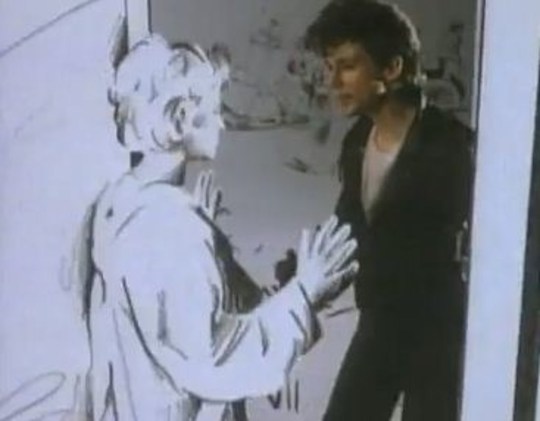
Taking a deeper analysis into the video Saussurean concepts of sign, signifier, and signified are present. In the music video, various signs are presented visually (such as characters, settings, and actions) alongside the auditory signifiers: the music and lyrics. The sketches shown throughout the video represent a signifier that conveys the concept of the protagonist imagined world or desires (signified). Analyzing this through Metz’s lens, the signifier of the animated characters entering the comic book world signifies a journey into fantasy or escapism. Escapism is a present theme in this video as it follows a narrative arc in which the protagonist transitions between the real world and the animated world representing the transition between reality and fantasy, echoing the themes of the song itself. The theme of escapism is also represented through the paradigmatic relation that is created with the contrast between the real-world setting and the animated world. Syntagmatic relations is also present in this video as the sequence of visual and auditory elements creates a syntagmatic structure.The progression of scenes, transitions, and actions forms a narrative sequence that guides the viewer through the story depicted in the video.

Analyzing through the lens of Roland Barthes the video might be perceived as selling the idea of transcending reality through love and imagination, much like how detergent ads sell the idea of transcending dirt to achieve cleanliness. In the video the animated world serves as a guide to a fantastical realm, inviting viewers to explore new possibilities and perspectives while guiding them through a journey of romance and adventure which can be connected to Barthes discussion on the cultural significance of travel guides. Barthes discusses the manipulation of historical narratives in films to convey certain ideologies which can be seen in the music video as it presents a narrative reminiscent of a romance or adventure film. The transformation of entering the comic book world can be seen as a modern interpretation of historical narratives, where the past is reimagined and romanticized for contemporary audiences. The romantic relationship depicted in the video can be interpreted as emblematic of idealized love or romanticized partnerships, reflecting societal norms and expectations surrounding relationships. Barthes discusses how modern myths are constructed and perpetuated through various forms of media and the music video constructs a myth around love, adventure, and escapism. The video perpetuates these myths through its visuals and narrative, reinforcing cultural ideals and values associated with romance and fantasy. In conclusion, analyzing the music video through different lenses reveals how the video constructs and perpetuates cultural myths surrounding love, adventure, and escapism. These lenses help us delve into the videos semiotic dimensions, exploring how the use of narrative, imagery, symbolism, signs and signifiers serves to create meaning within the visual and auditory text and reinforce societal norms.
youtube
The music video for "Nothing's Gonna Stop Us Now" by Starship was released in 1987 and played a significant role in the song's success. The video primarily takes place in a movie studio, reflecting the theme of the song being featured in the film “Mannequin.” This setting allows for various backdrops and sets to be utilized, adding visual interest and diversity to the video. The video follows a narrative that intertwines scenes from the movie “Mannequin” with footage of the band performing the song. The storyline of the movie, which revolves around a mannequin that comes to life, complements the message of the song about love overcoming obstacles. Throughout the video, shots of the band performing the song are interspersed with the narrative scenes. The band members are shown singing and playing their instruments with energy and enthusiasm, adding to the overall excitement of the video. The video includes romantic scenes between the characters from the movie, emphasizing the theme of love and connection. These scenes enhance the emotional impact of the song and reinforce its message of resilience and devotion. The video incorporates various visual effects, including transitions between scenes, lighting effects, and overlays, to enhance the overall aesthetic appeal. These effects contribute to the video's polished and professional look, aligning with the high production values of the song and its accompanying movie. The video features dynamic camera work and creative framing, capturing the energy of the band's performance and the emotional moments of the storyline.
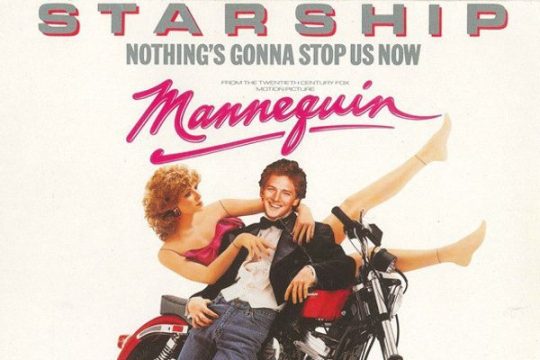
Analyzing the music video through the lens of Roland Barthes' essays from “Mythologies” offers an opportunity to deconstruct the cultural symbols and myths embedded within both the song and its visual representation. Barthes discussion of the manipulation of historical narratives to convey certain ideologies which can be seen in the video through elements such as the portrayal of the band members and use of dramatic backdrops that convey a sense of epic scale and evoke grandeur, triumph, and romance reminiscent of classical narratives. In the music video, themes of cleanliness, purity, and renewal, are symbolized through imagery such as bright, pristine settings, or the use of light and color to convey a sense of freshness and vitality. In the music video, their are references to travel and exploration, as the protagonists embark on a journey together against various scenic backdrops. These settings could serve as symbolic landscapes representing the adventure and possibilities inherent in love and partnership. The intimate moments portrayed between the protagonists represent domestic bliss and reinforce the narrative of enduring love and commitment which connects to Barthes values of stability, responsibility, and domesticity.

Metz discusses how cinema uses various codes and signs to convey meaning which is shown in the video as there are several codes such as visual imagery, music, lyrics, and performance. These codes work together to create a narrative and evoke emotions. The video follows a narrative structure that complements the song's lyrics. Based on the title and lyrics of the song it could be depicting a story of love, perseverance, or triumph over obstacles. The video utilizes cinematic techniques such as camera angles, editing, lighting, and choreography to convey its message. An example of this is the close-up shots that are used to emphasize emotions, while fast editing may create a sense of energy and excitement. Applying Metz's framework to the video allows for a deeper understanding of how its various elements work together to create meaning and evoke emotions in the viewer. In the video the facial expressions and body language of the performers, as well as the imagery used in the video to represent themes of love, determination, and overcoming obstacles. Saussure's theory of binary oppositions suggests that meaning is often constructed through the contrast between opposing concepts. Instances of binary oppositions are shown in the music video, such as contrasts in lighting, color palette, or visual motifs, which contribute to the overall message of the song. This lens gives us insights into how visual signs and symbols are used to convey meaning, emotion, and narrative in the context of popular culture and media production.

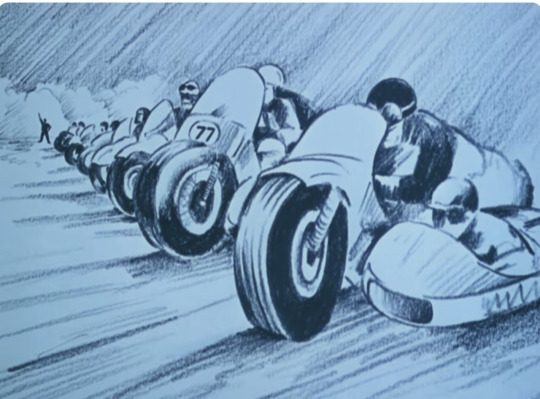
Discussion Questions:
Are there instances where the visuals seem to contradict the lyrical content?
What similarities can be drawn from both of these music videos? What about the actual songs? Is there any differences?
Do you think that the music videos represent the music correctly?
Why do you think love is portrayed the way it is in these music videos?
Do you think that semiotics were a present part when these videos were made?
Ferdinand de Saussure, Course in General Linguistics, trans. Wade Baskin (New York: McGraw-Hill Book Company, 1915)
Roland Barthes, Mythologies, trans. Annette Lavers (New York: The Noonday Press, 1972)
Metz, Christian,“Some Points in the Semiotics of Cinema. In Film Theory and Criticism, 65-77. Edited by Leo Braudy and Marshall Cohen (New York/Oxford: Oxford University Press, 2009)
10 notes
·
View notes
Text
Music Video Analysis
Part 1: "thank u, next"
youtube
Ariana Grande's "thank u, next" music video is a vibrant homage to iconic romantic comedy movies, including "Mean Girls," "Legally Blonde," "13 Going on 30," and "Bring It On." In the video, Grande recreates memorable scenes from these films while infusing them with her own unique style and narrative, inviting famous friends and other celebrities that have been connected to her to reference her life within these recreations. Throughout the video, Grande reflects on themes of personal growth, self-love, and empowerment, and cleverly addresses her own love life and the public's fascination with it. Having publicly addressed her love for old rom-coms, she also celebrates the strength and resilience of female protagonists from the rom-coms she references. The video showcases Grande's creativity and artistic vision, as she embraces her independence and confidently moves forward after experiencing heartbreak. Overall, "thank u, next" is a visually captivating and empowering tribute to both iconic movies and Grande's own journey of self-discovery.
Deleuze explores the complex interplay between repetition, generality, and law, challenging traditional philosophical notions. Deleuze emphasizes “repetition and generality are distinct; repetition involves non-exchangeable singularities, while generality allows for exchange or substitution of terms.”(1) For him, repetition is not about replicating identical instances but rather about the emergence of difference within a repeated pattern. He argues that genuine repetition involves the recurrence of non-identical elements or singularities, which he terms "difference in itself." This notion of difference disrupts traditional conceptions of identity and sameness, highlighting the dynamic and unpredictable nature of repetition.
Each segment of the “thank u, next” music video references iconic romantic comedy movies, and represents a repetition of familiar narratives and tropes. However, rather than simply replicating these stories, Grande infuses them with her own unique perspective and experiences. We see this from the very start, when she recreates the iconic introduction of the character Regina George from “Mean Girls” (0:00:01). While the general idea and tone of the scene remains the same, she replaces Regina with herself, and inserts many references from her own life that were considered scandalous by the media, poking fun at the public’s interest. In another shot, still as Regina, Grande is scrapbooking in the famous Burn Book from “Mean Girls” (0:00:43), but instead of writing nasty secrets like the original movie does, she pays homage to her previous relationships with nothing but love and respect, aligning with the lyrics of each ex while she flips the page from one ex to the next. These reinterpretations of familiar narratives highlight Deleuze's notion of difference within repetition. Despite drawing inspiration from existing cultural tropes, Grande introduces new elements and perspectives, allowing for the emergence of difference and novelty within the repeated patterns.
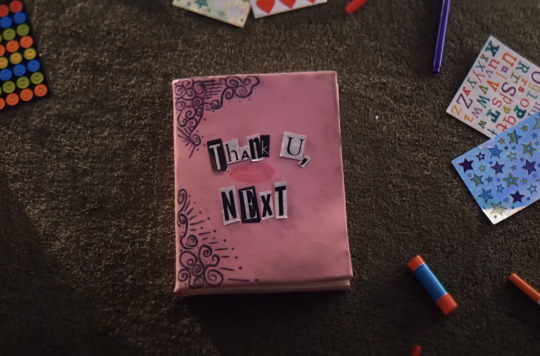
Baudrillard examines the dominance of consumption and the signifier in capitalist societies, exploring how “postmodern communication technologies, principally television, are said to flood the world with self-generating, self-mirroring images; and experience” (2). He contrasts simulation with representation, arguing that simulation has replaced representation, challenging conventional notions of reality and power dynamics. Images no longer reflect reality but create their own hyperreal realm, blurring the boundaries between real and simulated experiences. His work offers a critical perspective on the impact of hyperreality, highlighting the complexities of navigating between real and simulated realms.
In "thank u, next", Grande’s idealization of high school culture and romantic comedy (rom-com) tropes contributes to the construction of a hyperreal world, resonating with Jean Baudrillard's concept of simulation. The video references iconic high school movies like "Mean Girls" and "Bring It On," as well as rom-com classics such as "Legally Blonde" and "13 Going on 30," embodying specific tropes and narratives associated with adolescence and romantic relationships. She blurs the line of reality and simulation consistently. In one instance, Grande pays homage to the movie “Legally Blonde”, where she replaces the main character, Elle, with herself. When she talks to Jennifer Coolidge in a montage referencing the iconic hair salon, who originally plays Paulette in the film, she talks about her real life relationship as Ariana Grande, while Coolidge fully embodies her original character and responds as Paulette (0:03:20). With this exaggerated and hilarious reference to the movie, Grande’s using these classic rom-com scenes to explore her own reality ends up contributing to the construction of a hyperreal realm, where the boundaries between reality and fiction are blurred, and images and narratives take on a heightened, almost surreal quality. Baudrillard argues that in hyperreality, signs and symbols no longer represent anything real but instead simulate reality itself. Grande's idealization of high school culture and rom-com tropes in "thank u, next" contributes to the construction of a hyperreal world, where the boundaries between reality and fiction are blurred, and images and narratives take on a life of their own in the realm of popular culture.
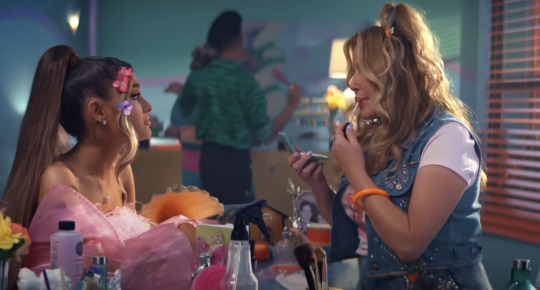
Fredric Jameson explores the impact of postmodernism on social, economic, and cultural changes, challenging the idea of a 'post-industrial' phase and highlighting capitalism's expanded hegemony. He argues that capitalism's power has intensified throughout the years, and examines how changes in capitalism's mode of production relate to new forms of cultural production, identifying postmodernism in literature, music, film, and environments as characterized by surface, pastiche, and paranoia. He discusses pastiche as a key element in postmodernism, representing a neutral mimicry without parody's satirical impulse, reflecting a shift towards stylistic diversity.
Fredric Jameson's analysis of postmodernism within the framework of consumer society underscores the dominance of capitalism in shaping cultural production and consumption. In his essay, he critiques the notion of a distinct 'post-industrial' phase, arguing instead for the expanded hegemony of capitalism. He highlights how changes in the mode of capitalist production influence cultural forms and expressions. The video itself is a product of the entertainment industry, driven by commercial interests and profit motives. It serves as a form of cultural commodity produced and consumed within a capitalist system. The references to iconic romantic comedy movies in the music video can be seen as part of a broader cultural phenomenon where nostalgia is commodified and marketed to consumers. The inclusion of many famous celebrities as the other stars in the video also highlight this obvious tactic of gaining consumer's attention. Fredric Jameson's exploration of postmodernism also offers insights into how Ariana Grande's "thank u, next" music video engages with this cultural phenomenon. Postmodernism, characterized by Jameson as a cultural shift towards surface, pastiche, and a blurring of boundaries between reality and fiction, resonates with various aspects of the music video. Grande's incorporation of references to iconic romantic comedy movies and high school culture embodies the postmodern tendency towards pastiche, where cultural elements are borrowed and recontextualized without necessarily critiquing or subverting them. While she does use them to focus on the story of her own life, the original elements of the rom-com movies aren’t particularly built on. The stylized and exaggerated portrayal of these cultural tropes reflects a focus on surface aesthetics and a blurring of the distinction between original and copied content.

Part 2: "Freedom! '90"
youtube
"Freedom! '90" is not just a music video but a statement of artistic intent by George Michael, featuring iconic supermodels (ie. Naomi Campbell, Cindy Crawford) lip-syncing the song's lyrics without himself into the video. This decision to have the models represent him was a way to signal his desire to break free from the manufactured pop star image that had defined his earlier career. The video is visually captivating, with the models of all different looks exuding confidence and attitude as they strut and pose in an abandoned mansion. Their presence symbolizes not only glamor and beauty but also a sense of power and independence. By placing the focus on these iconic figures rather than himself, George Michael effectively distances himself from his previous image and asserts his autonomy as an artist. Thematically, the video explores concepts of liberation and authenticity. It represents a departure from the glossy, commercialized imagery typically associated with pop music videos of the time. Instead, "Freedom! '90" embraces a more raw and authentic aesthetic, reflecting Michael's personal journey towards self-discovery and creative freedom.
Through the lens of Deleuze, who emphasizes the idea that repetition involves non-exchangeable singularities and challenges established norms or structures, we can analyze Michael’s music video as a unique singularity amongst music videos themselves. In contrast to typical music videos that portray the artists in a spotlighted fashion and generally shape the narratives around the presence of the singers, “Freedom! 90” chooses to feature supermodels lip-syncing to his song. This departure from the expected repetition of the artist's presence challenges the conventional structure of music videos and disrupts the established norms of representation. Additionally, his decision to step back and allow the models to take center stage can be seen as a form of resistance against the manufactured image and commercial pressures often associated with the music industry. In this video, he intentionally distances himself from his previous image, which is symbolically conveyed through visual elements, like leaking water. Water is often associated with purification and renewal, and its presence in the video suggests a cleansing process—a metaphorical washing away of the old to make room for the new. As the water pours from various sources like the walls and the ceiling (0:03:22), it represents a release from the pressures and expectations of celebrity, allowing George Michael to distance himself from his previous image and embrace a fresh start. By breaking away from the expected repetition of celebrity presence, the video embraces a new form of repetition—one that is non-exchangeable and challenges the norms of representation and identity.
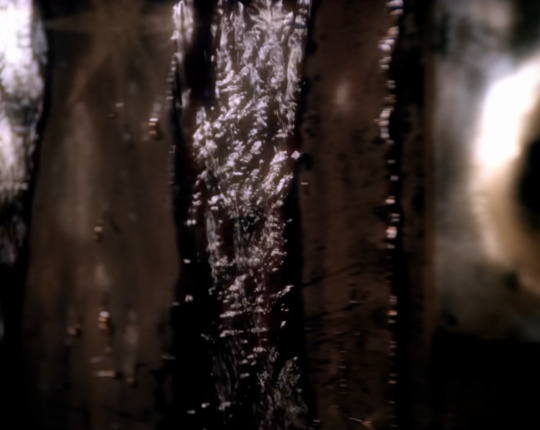
In Baudrillard's framework, Michael’s breaks free of the traditional simulation of artists we typically see from the music industry. Many artists in the music industry are carefully curated and marketed by record labels to fit specific personas or images that appeal to target demographics. These constructed identities don’t reflect the artist's true self or experiences, leading to a simulated version of their identity being presented to the public. The music industry relies heavily on media coverage and public relations strategies to shape public perception of artists and their work. In his early years as a pop star with Wham! and as a solo artist, George Michael was presented to the public as a polished, marketable figure with carefully curated image and persona. This manufactured image, while successful commercially, often overshadowed his true identity and artistic intentions. In later years, George Michael sought to break free from the constraints of his manufactured pop star image and assert his authenticity as an artist. As his lyrics illustrate the process of “breaking free” and deviating from societal expectations, he includes the iconic blazing jacket (0:2:18). The blazing jacket worn by a model in the video serves as a powerful metaphor for shedding the past and breaking free from the constraints of fame. As the jacket ignites and burns, it represents the destruction of the old persona—the glossy, manufactured pop star image that George Michael had become known for. By showcasing the jacket engulfed in flames, the video symbolizes the artist's desire to let go of his past identity and emerge anew.
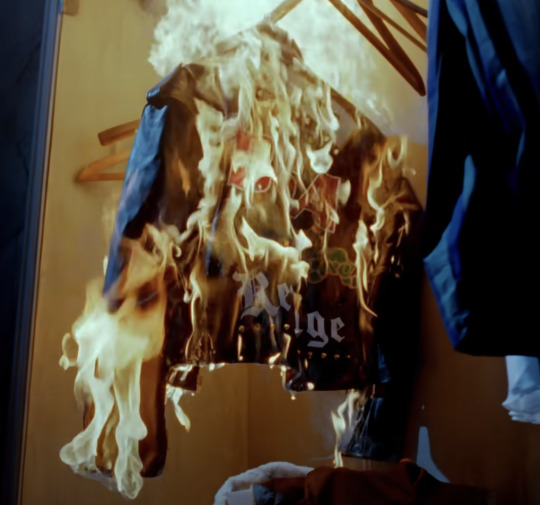
Jameson warns readers about the “death of the subject”(3), refers to a shift in postmodern culture where traditional notions of individuality and personal identity are destabilized or decentered. This concept suggests that in contemporary society, the individual subject becomes increasingly fragmented and deconstructed, unable to maintain a coherent sense of self amidst the complexities of postmodern life. He argues that various cultural and technological developments, such as the rise of mass media, globalization, and digital communication, contribute to the dissolution of the subject. These forces work to erode the boundaries between individual and collective identity, as well as between public and private spheres. As a result, the subject is no longer able to maintain a stable and unified identity but instead becomes fragmented and dispersed across multiple discourses and social contexts. In George Michael's "Freedom! '90" music video, he subverts the notion of the "death of the subject" by reclaiming agency and autonomy over his own identity and artistic expression. Towards the end of the video, the jukebox and guitar previously featured are blown up. These actions can symbolize a radical departure from the artist's past image and musical style. These acts can be seen as symbolic gestures of rebellion against the commodification of music and the constraints of traditional celebrity culture. The jukebox and guitar represent established symbols of music consumption and rock star imagery. By blowing them up, the video rejects the superficiality and commercialism associated with these symbols, challenging the idea that music and art can be reduced to mere commodities for consumption. Instead, it asserts the importance of authenticity and creative freedom in the face of commercial pressures. It can also signify a declaration of independence and a refusal to conform to expectations imposed by others. Additionally, the destruction of these symbols may represent a desire to start anew and redefine oneself creatively. Blowing up the jukebox and guitar in the music video can be interpreted as a symbolic act of liberation and a statement of artistic autonomy, subverting Jameson’s idea of “death of the subject” and challenging established norms and cultural expectations.
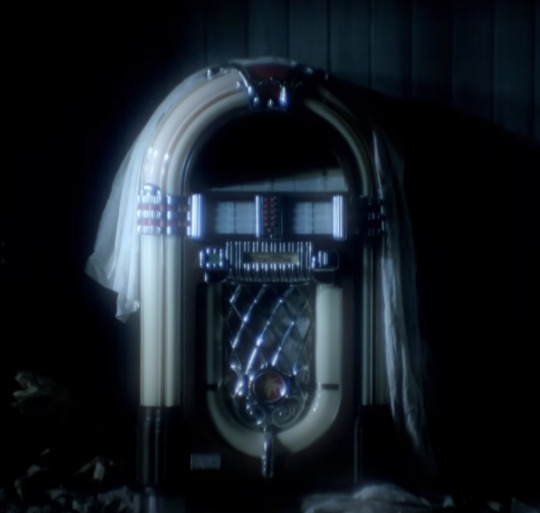
Questions: - How does Grande's use of references to iconic movies contribute to the construction of a hyperreal realm, as discussed by Baudrillard? What insights does this offer into the dynamics of cultural consumption, representation, and the construction of reality in the digital age? - How does Ariana Grande's "thank u, next" music video embody Jameson’s idea of postmodern tendencies, particularly in the video’s engagement with commercialized nostalgia and use of fame? - How does Deleuze's notion of repetition involving non-exchangeable singularities help us understand the significance of this departure from the expected repetition of celebrity presence? How does it contribute to the exploration of authenticity and artistic autonomy in the video?
Works Cited
Deleuze, Giles, "Introduction: Repetition and Difference" (New York, NY, Columbia University Press: 1994).
Baudrillard, Jean, “Simulacra and Simulations” (New York, NY, Pearson Education Limited: 1992).
Jameson, Fredric, ““Postmodernism and Consumer Society”(New York, NY, Pearson Education Limited: 1992).
8 notes
·
View notes
Text
Reading Notes 1: Marx and Engels to Althusser to Benjamin
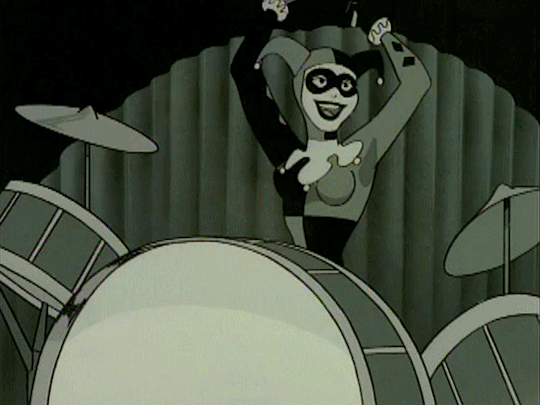
In “The Ruling Class and The Ruling Ideas,” “Ideology and Ideological State Apparatuses,” and “The Work of Art in the Age of Mechanical Reproduction,” Karl Marx and Frederick Engels, Louis Althusser, and Walter Benjamin, respectively, provide insight on our introduction to ideology and culturalism.
What is the division of mental and material labour and how does it manifest in society?
What is the relationship between the state apparatus and the ideological state apparatuses?
How have the processes of reproducing works of art changed over time, and how have changes in reproduction altered the relationship between a piece of art and its “original” object?
@theuncannyprofessoro
20 notes
·
View notes
Text
@theuncannyprofessoro
10 notes
·
View notes
Text
@theuncannyprofessoro
15 notes
·
View notes
Text
Poststructuralism and Postmodernism
PART I: Freedom! '90" George Michael
youtube
The music video for "Freedom! '90" by George Michael is a visually iconic and cinematic piece directed by David Fincher. Released in 1990, the video is known for its stylish and memorable scenes. The video does not feature George Michael himself; instead, it showcases five of the era's top supermodels: Naomi Campbell, Linda Evangelista, Christy Turlington, Cindy Crawford, and Tatjana Patitz. The supermodels lip-sync the lyrics of the song and perform various scenes. The video is a departure from Michael's earlier image and marks a significant moment in his career. It symbolizes his decision to step away from the spotlight and let his music speak for itself. The models, who were at the peak of their fame, are shown mouthing the lyrics, highlighting a transition from the image-driven phase of George Michael's career to a focus on his music and artistic expression. The video has a chic and glamorous aesthetic, combining visually stunning scenes of the models in rooms of an abandoned house, posing through streaks of sunlight and hues of blueshimmering on their faces, glimpses of water, and modern means for musical transmission.

Thinking in terms of Deleuze’s theory on repetition, multiple mediums of audio transmission can be seen throughout the music video. At 0:0:14, one of the models uses a laser to turn on a futuristic vinyl stereo setup, then the shot pans to a vhs tape player. The shot switches between these two music playing set ups and turns to a cd cover of george michael’s album “Listen Without Prejudice”. This emphasis on the continued auditory media as a means of communication suggests the duplication of the same ideas transcending generations of innovation, as well as creating and distributing music throughout multiple mediums to send a message. This evolution of technology containing an evolving idea of transmitting auditory media to the masses represents Deleuze’s idea that replication is a means to transform the meaning of an idea. The more these technological devices evolve, the more efficient and optimized listening to music can be, the more capabilities are possible and the more people can be reached via music.
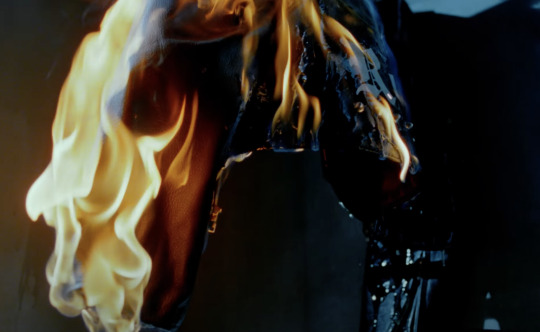
Through the perspective of Baudrillard, it can be interpreted that Michael is creating a new hyperreality for himself in the video. By using specific signs throughout the development of the shots, Michael distorts and solidifies new meanings of objects within the space. For instance, at 0:2:18, a motorcycle jacket is seen burning on its hanger. Delving into the meaning in real life, the BSA jacket shown in the video was an iconic piece that Michael wore during the Faith tour, where he experienced huge commercial success as a pop star. By burning the jacket, Michael metaphorically sheds his old identity and embraces a new sense of freedom and authenticity. The act of burning the jacket serves as a symbolic rebirth and a declaration of independence from the expectations of the music industry. Using Baudrillard’s terms, the burning of the jacket, as a form of simulacra, denotes the destruction of the reality Michael was currently in, and the creation of simulation through Michael’s autonomy of creative direction. Through another analysis of the signs in the video, the different forms of electronic mass media, Baudrillard’s theory suggests these signs maintain the illusion of reality.
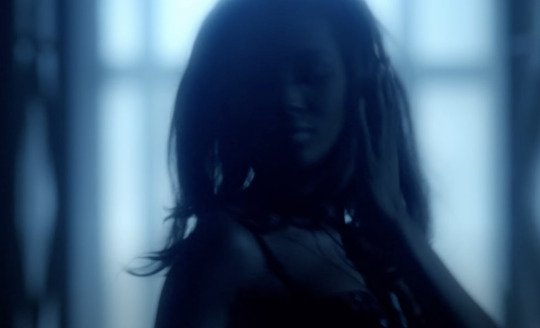
At 0:0:45, Naomi Campbell is seen listening to the song through headphones, on top of the other mediums of media transmission previously mentioned. In addition, the main feature of the video is all of the models lip synching the song instead of Michael himself. Baudrillard’s theory applies to how mass media, especially in the form of electronics, maintains the illusion of reality. These auditory devices in essence “control” the models in this hyperreality, using them as the means to convey the message of the song. The video begins with them turning on the devices, and ends with them conveying the same lyrics that were being played by the electronics.
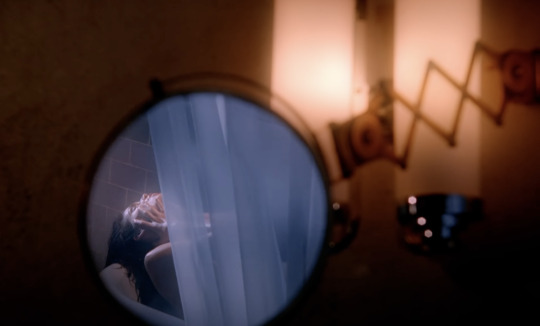
Finally, examining the video utilizing the theories of Jameson’s postmodernism, the video can be interpreted through symbols used of the shallow nature of commercialization and consumer culture. Jameson's criticism of postmodernism includes the notion of "empty signifiers," where cultural products lack depth and critical engagement. In the video, the glamorous and stylish representation of supermodels, although visually striking, may be seen as lacking in substantive content. The emphasis on aesthetics and surface-level appeal aligns with Jameson's critique of the shallowness in postmodern cultural production. Though this may be true just looking at the visual elements in the video, the lyrical message behind the song tells another story. Famousky, Michael sings the line “sometimes the clothes do not make the man”. Meaning that one may be satisfied with a material means of happiness, but they are a shallow representation of the individual beyond their capitalistic idealization. The use of models in the video highlights the need to use commercially accepted visions of beauty and glamor to convey messages to the masses, because this is used by the ruling class. The main theme of the song is Michael’s desire to distance himself from the highly commercial pop star image of himself, singing “But today the way I play the game is not the same, No way, Think I’m gonna get myself happy”. He rejects the emptiness of his previous images, and wants to pursue genuine happiness through feeling genuine in his artistry. Models are often used as surface level vessels to promote brands and corporations, it can be interpreted that Michael uses them to convey the messages of “Freedom” to encourage people to break free from the shackles of consumer culture and pursue happiness outside of material gain.
Through Deleuze's theory on repetition, the use of multiple mediums for audio transmission symbolizes the evolution of technology and the transformative power of replicating ideas across generations. In Baudrillard's lens, the video becomes a narrative of Michael creating a new reality for himself by distorting and solidifying meanings of objects, especially through the symbolic act of burning his iconic jacket. Baudrillard's hyperreality concept is evident in the models being controlled by electronic mass media, maintaining the illusion of reality. Furthermore, Jameson's postmodernism critique unveils a juxtaposition between the visually glamorous representation of supermodels and the song's deeper message, revealing the emptiness of commercialization and consumer culture. The video challenges the superficiality of postmodern cultural production by using models as vessels to convey a message urging people to break free from the constraints of a consumerist society that controls them.
Discussion Questions:
What scenes in the video stood out to you in terms of commercialism/consumerism, how does Michael portray this?
Do you think George Michael is truly breaking free from a commercialized pop star when he continues to release music within the culture industry?
PART II: "1979" The Smashing Pumpkins
youtube
The music video for "1979" by the Smashing Pumpkins, a popular 90s Rock song depicts the lives of suburban youth in the 1970s. It features a series of seemingly random and disconnected snapshots that capture the experiences of teenage life, including house parties, driving around town, and various interactions. The video conveys a sense of nostalgia and the carefree spirit of youth, emphasizing the themes of rebellion, friendship, and the search for identity. The visual style is characterized by a documentary-like approach, with a mix of intimate moments and energetic scenes, reflecting the diversity and complexity of youth culture, along with an idealization of being young. The scenes are depicted in snapshots like memories that fill the viewer with a sense of yearning for a time gone by. Overall, the video complements the song's themes and provides a visual narrative that resonates with the song's exploration of the teenage experience in 1979.

Fredric Jameson in his article “Postmodernism and Consumerist Society,” delves into the transformations in social, economic, and cultural realms instigated by postmodernism. It challenges the conventional idea of a 'post-industrial' phase and underscores the heightened dominance of capitalism. Jameson critiques the perspectives of thinkers like Daniel Bell, contending that capitalism has solidified its influence. The reading explores how shifts in capitalism's mode of production align with novel forms of cultural expression. It characterizes postmodernism in literature, music, film, and environments by its emphasis on surface, pastiche, and paranoia. Jameson examines pastiche in postmodernism, defining it as a neutral form of aestheticism devoid of parody's satirical impulse. This reflects a move towards stylistic diversity and heterogeneity. Additionally, he addresses the "death of the subject" in postmodernism, challenging the notion of unique personal identities and individualism as central tenets of classical modernism. Through this perspective, the music video for “1979”, complemented with the lyricism, engages with nostalgia coupled with an idealization of consumer culture associated with youth culture. For instance, the video features several scenes of teens driving in a vintage car (first seen at 0:0:23). The car is associated with teenage freedom and a sense of identity, leading to endless possibilities and activities that the teens take advantage of. It's also the very function of the fleeting nature of youth itself The suburban setting also provides an easy showcase for consumerist culture. According to Jameson, while talking about the movie Body Heat, he explains “One begins to realise after a while that the small town setting has a crucial strategic function: it allows the film to do without most of the signals and references which we might associate with the contemporary world, with consumer society - the appliances and artifacts, the high rises, the object world of late capitalism (170)” (1). All of the images shown throughout the video, the cars, the long streets to cruise, the band, and the parties are placed among a suburban setting, as the singer sits in the back of a car reflecting and longing for the image of a “simpler time”. This simplicity however, encourages the material exchange of money for experience, dimming the sense of uniqueness that is commodified by the feeling of youth. Thus, youth culture and consumer culture go hand in hand. Youths think that their experience is shaped by a series of unique memories, but really the subconscious influence of materialism is showcased right in front of their eyes. Overall, the video and lyrics depict a constructed, simulated representation of youth culture and nostalgia, reflecting the influence of media and cultural simulations on our perceptions of reality.

Gilles Deleuze's "Introduction: Difference and Repetition" provides a foundation for his philosophical exploration of difference and repetition. Deleuze challenges traditional philosophical concepts by emphasizing the primacy of difference over identity and repetition over representation. He critiques the way Western thought has historically focused on identity and homogeneity, arguing for the significance of diversity, multiplicity, and differentiation. Deleuze introduces the idea of "difference in itself" and explores how difference operates as a creative force, generating new possibilities and forms. He also investigates the concept of repetition, not as a mere duplication of the same but as a transformative and generative process to shape new meaning out of reproduction. The introduction sets the stage for Deleuze's intricate analysis of these themes throughout the rest of the work, challenging conventional philosophical paradigms and paving the way for his unique philosophical perspective. Deleuze's concept of repetition as a transformative process rather than a mere duplication resonates with the themes in "1979." The song and its video capture the repetition of certain experiences in youth culture, such as parties and social interactions. Deleuze's idea of repetition as a creative force that generates novelty. It’s important to note that the video and song was written in the year 1997, yet the video takes place, like the title suggests, in the year 1979. Thus, the video is a repetition of the representation of youth culture in the 1970s. Although not identical, this representation allows for interpretation of what this time period looked like, and develops new meaning from the spectatorship of the viewer. Deleuze emphasizes that repetition of signs, especially relating to the concept of the “self” are not what signs are, but rather their transformative properties of what they can become. Deleuze challenges fixed identities, and the music video portrays a fluid sense of identity within the youth culture it represents. The diverse scenes and interactions showcase a multiplicity of experiences and personalities, resonating with Deleuze's call for an understanding of identity that goes beyond rigid categories. Due to the diverse experiences in the music video, throwing chairs into the pool (0:2:35) and bowling with bottles in the grocery store (0:3:53), these ideas are representative of the heterogeneous culture centered around youth, though unified under one concept of being carefree. All in all, Gilles Deleuze's philosophical theory serves as a philosophical groundwork that challenges conventional notions of identity, emphasizing the transformative nature of difference and repetition. This resonates with the themes in the Smashing Pumpkins' "1979'' music video, where the repetition of youth experiences becomes a creative force generating new meanings. Despite the video being set in 1979, its repetition serves as a representation of the era, allowing for diverse interpretations and emphasizing Deleuze's idea that signs transform and generate novelty. The video's portrayal of fluid and heterogeneous identities aligns with Deleuze's call for understanding beyond rigid categories, showcasing a multiplicity of experiences within a unified concept of carefree youth culture. Through scenes of unconventional activities, the video captures the transformative properties of repetition, illustrating Deleuze's philosophy in the context of youth identity and cultural representation.

Jean Baudrillard's "Simulacra and Simulations" delves into the concept of hyperreality, where simulations and copies come to dominate and replace the original reality they represent. Baudrillard argues that in contemporary society, signs and symbols no longer point to an underlying reality but instead create a self-referential system. He introduces the idea of simulacra, which are copies without an original, and suggests that simulations have become more real and influential than the reality they mimic. Baudrillard explores the impact of media, technology, and consumer culture on shaping our perceptions, challenging traditional notions of reality and representation. The essay delves into the dissolution of boundaries between reality and simulation, questioning the authenticity of experiences and identities in a world increasingly saturated with signs and images. Putting this lens over the analysis of “1979”, a hyperreality is created by the setting of the music video. This simulation capitalizes off of the simplistic nature of youth and creates a feeling of nostalgia and longing for a carefree version of life. Even the lyrics suggest this love of a time gone by coupled with the dread of growing up. “That we don't even care as restless as we are. We feel the pull in the land of a thousand guilts. And poured cement (0:2:08)”. Baudrillard notes this certain draw towards simulations stating that “When the real is no longer what it used to be, nostalgia assumes its full meaning (153)” (2). The music video was made in the 1990s, but about the 1970s, emphasizing that the meaning of the song and music video is a means to cope with the loss of the carefree days of youth. Baudrillard would argue that the video is not a direct reflection of reality but a simulation created by media representations, contributing to the construction of a hyperreal youth culture. Baudrillard's concept of simulacra suggests that in a hyperreal world, identities become fluid and constructed, influenced by media and cultural simulations. The portrayal of youth in the video reflects a simulation of identity influenced by cultural representations rather than an authentic expression of individual experiences. The video itself follows snapshots of youths and experiences reminiscent of memories, from signs like parties to joyrides. However, the simulation created through the music video itself lacks depth, and is a generalization and idealization of youth culture rather than unique experiences. Baudrillard explained the nature of the hyperreal and simulacra, noting “It retains all the features, the whole discourse of traditional production, but it is nothing more than its scaled-down refraction (159)” (3).
The video, set against the backdrop of suburban youth in the 1970s, becomes a centerpiece that showcases both an idealized past and a constructed representation of youth culture. Jameson's critique of postmodernism's emphasis on surface, pastiche, and the "death of the subject" resonates with the video's depiction of fragmented memories that present a shallow and idealized version of youth.
Deleuze's philosophy of difference and repetition aligns with the diverse and tokenized aspects of youth experiences depicted in the video. The repetition of the aura of the year 1979 becomes a creative force, generating new meanings and contributing to a fluid and heterogeneous sense of identity, specifically around youth culture.
Baudrillard's concept of hyperreality and simulacra further deepens the analysis. The video, portraying an idealized version of the 1970s, becomes a hyperreal simulation that blurs the boundaries between reality and representation. The nostalgia felt by the viewer is not for a historical reality but for a carefully constructed and simulated past.
Discussion Questions:
Can people who weren’t living in the 1970s still feel nostalgic about this time? Why or why not?
Are our experiences, especially in youth, a result of consumer culture, or is youth culture detached from consumerism?
Works Cited:
Jameson, Fredric, ““Postmodernism and Consumer Society”(New York, NY, Pearson Education Limited: 1992).
Baudrillard, Jean, “Simulacra and Simulations” (New York, NY, Pearson Education Limited: 1992).
Deleuze, Giles, "Introduction: Repetition and Difference" (New York, NY, Columbia University Press: 1994)
@theuncannyprofessoro
10 notes
·
View notes
Text
Panel Presentation: "Telephone" by Lady Gaga ft. Beyoncé & "Q.U.E.E.N." by Janelle Monáe ft. Erykah Badu
By Sophie Goldberg
youtube
"Telephone" by Lady Gaga ft. Beyoncé
The music video Telephone by Lady Gaga ft. Beyoncé serves as a continuation of "Paparazzi", where Gaga was arrested for killing her abusive boyfriend by poisoning his drink. It features a storyline where Lady Gaga is imprisoned but eventually escapes with Beyoncé's help, and they then go on to poison Beyoncé’s boyfriend and others in a diner and run from the police.
Laura Mulvey, “Visual Pleasure and Narrative Cinema”
Mulvey discusses the concept of the male gaze, where the camera represents the perspective of a heterosexual male viewer, objectifying female characters for the pleasure of the male audience. Beyonces and Lady Gaga’s portrayal aligns with certain aspects of the male gaze. The music video inevitably attracts male attention as the camera frequently lingers on their bodies and costumes, emphasizing their sexuality and allure. Mulvey states “Traditionally, the woman displayed has functioned on two levels: as erotic object for the characters within the screen story, and as erotic object for the spectator within the auditorium” (716). For example, when Lady Gaga first enters the prison everyone is wearing revealing clothes, and as she's pushed into her cell officers strip her down, leaving her with nothing but fishnets. Another instance occurs when Lady Gaga and three other women wear studded bikinis and engage in a provocative dance down the prison corridors. Spectators also see them through the lens of a security camera, furthering the voyeuristic aspect.

However in "Telephone," both Lady Gaga and Beyoncé also challenge traditional notions of passive femininity by taking on assertive, dominant roles. Mulvey states that “pleasure in looking has been split between active/male and passive/female’ (715). Women are presented as spectacle as the man's role is “the active one of forwarding the story,” (716) Lady Gaga and Beyoncé disrupt traditional narrative conventions by defying societal expectations of female passivity and instead taking control of their own narrative. Gaga and Beyoncé portray themselves as empowered and even dangerous figures as in the music video there are depicted acts of violence against men.

Bell Hooks, “Oppositional Gaze: Black Female Spectators”
Hooks discusses how Black female spectators often engage with media representations critically as “ mass media was a system of knowledge and power reproducing and maintaining white supremacy. To stare at the television, or mainstream movies, to engage its images, was to engage its negation of black representation.” (308) In "Telephone," Beyoncé's confident demeanor, assertive actions, and her role as the one with more agency than Lady Gaga—having the power to bail her out of jail—can be viewed as empowering examples of Black women asserting their autonomy within mainstream media.

Furthermore, Hooks critiques mainstream media for its tendency to eroticize and objectify Black women's bodies. In the video, there is a moment in which there is a high angle shot of Beyoncé's cleavage as she sits across from her boyfriend in the diner. Although, within the framework of the oppositional gaze, Beyoncé's character adopts a rebellious stance, refusing to conform to the gaze of desire and possession. Instead, she asserts her power by poisoning her misogynistic boyfriend and evading the police.
Audre Lorde, “Age, Race, Class, and Sex: Women Redefining Difference”
In Lorde's essay, she states “As women, we must root out internalized patterns of oppression within ourselves if we are to move beyond the most superficial aspects of social change.” (122) One such pattern is internalized misogyny, where women devalue themselves and others, which can lead to judgmental attitudes towards different lifestyles and choices. In "Telephone," Beyoncé exemplifies Lorde's words by not passing judgment on Lady Gaga's choices when she bails her out of jail. Despite their differing lifestyles, they unite against a common oppressor. Furthermore, societal expectations surrounding gender roles can also be internalized forms of oppression, such as conforming to domestic responsibilities. In the video Lady Gaga challenge these norms when she incorporates the stereotype of women in the kitchen within a segment titled “Lets Make a Sandwich”, but instead of adhering to these norms she instead puts poison in all of the food.

Furthermore, Lorde underscores the need to recognize differences among women as equals , relate across the differences, and utilize them to enrich collective visions and struggles. This is shown in the music video through the camaraderie and alliance depicted between Lady Gaga and Beyoncé. The video embraces diversity within feminism, showcasing representations of differences in sexuality and race, yet emphasizing a shared goal of empowerment. This sentiment is also echoed in the lyrics, “Boy, the way you blowin' up my phone , Won't make me leave no faster, Put my coat on faster, Leave my girls no faster”

youtube
"Q.U.E.E.N." by Janelle Monáe ft. Erykah Badu
Janelle Monáe's music video for 'Q.U.E.E.N.,' featuring Erykah Badu, serves as a freedom anthem within a science fiction dystopia. The title itself, 'Q.U.E.E.N.,' is an acronym representing marginalized communities: Queer, Untouchables, Emigrants, Excommunicated, and Negroid, reclaiming royal imagery to challenge traditional hierarchies of race, sexuality, and class. Monáe's Afrofuturist vision suggests a revolution, where marginalized communities and differences are celebrated rather than ostracized. The music video features rebel time-travelers that are frozen in a museum and brought to life by music. In the video's narrative, the song functions as part of a “musical weapons program” that disrupts the status quo, allowing the rebels to move through history and forge a new future in the present.
Laura Mulvey “Visual Pleasure and Narrative Cinema”
Mulvey argues that traditional cinematic narratives often reinforce patriarchal ideologies and power structures as they cater to a male gaze. The music video "Q.U.E.E.N." offers a narrative that challenges this as it features strong, empowered female protagonists who challenge traditional gender roles and expectations. Janelle Monáe wears a black-and-white tuxedo, disrupting the traditional notion of gendered clothing styles. The ladies all dance with each other and build eachother up such as when they reply and affirm each other “Is it peculiar that she twerk in the mirror? And am I weird to dance alone late at night? (Nah) And is it true we're all insane? (Yeah) And I just tell 'em, "No we ain't" and get down”. Here, the mention of twerking in the mirror is not sexualized but used to empower the female body.
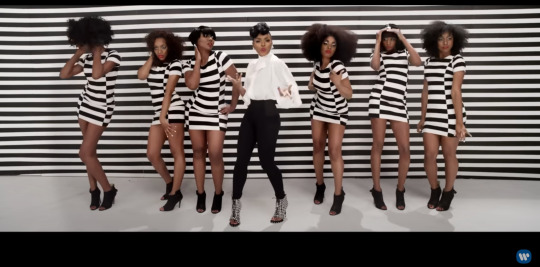
Bell Hooks, “Oppositional Gaze: Black Female Spectators”
The oppositional gaze is seen in the music video as Black female spectators engage with the visual representation of empowerment and resistance depicted in the video. Monáe uses both queerness and Blackness as examples of modern “freakishness.” Monáe doesn't assign a "freaky" status to queerness or Blackness herself, instead, she challenges listeners to interrogate why these identities are perceived as "freaky." She suggests that what society deems as "freaky" is simply the act of being true to oneself. The lyrics declare those differences as things to be proud of stating "Even if it makes others uncomfortable, I will love who I am". Monáe and Erykah Badu illustrate the way society "freakifies" their Blackness, showcasing how joy and celebration within Black culture are often viewed negatively due to racist stereotypes. The hook in the song highlights this, asking: “Am I a freak for dancing around? Am I a freak for getting down? I’m cutting up, don’t cut me down.” Black female spectators can find empowerment in seeing how the song recognizes differences and individuality as prideful assets.
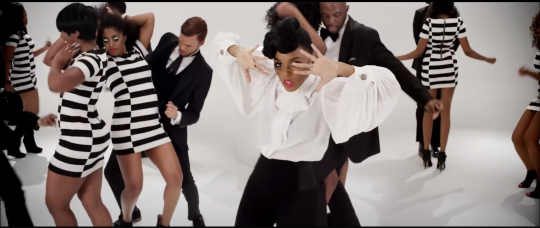
Audre Lorde, “Age, Race, Class, and Sex: Women Redefining Difference”
Lorde emphasizes the importance of recognizing the intersections of age, race, class, and sex in understanding women's experiences. The video highlights the oppression faced by diverse identities and experiences of Black women, as well as showcases their resilience in the face of it. The lyrics “Add us to equations but they'll never make us equal” resonates with Lorde’s claim that simply incorporating marginalized groups into existing systems does not address the underlying power imbalances or inequalities. Monáe’s next lyrics recognizes these inequalities stating “She who writes the movie owns the script and the sequel, So why ain't the stealing of my rights made illegal? They keep us underground working hard for the greedy, But when it's time pay they turn around and call us needy (needy)” Lorde further advocates for collective action and solidarity among women of different backgrounds to achieve liberation. In "Q.U.E.E.N.," the song's message of female empowerment and solidarity is highlighted as Monáe and Badu come together to celebrate different identities, for example sexual and racial identity. Janelle Monáe promotes unity and collaboration among women as she says “Will you be electric sheep? Electric ladies, will you sleep? Or will you preach?” According to Janelle Monáe it is up to this community and this generation to create its new norm and break down the walls that limit them.

Discussion Questions:
Lorde says ““By and large within the women’s movement today, white women focus upon their oppression as women and ignore differences of race, sexual preference, class and age. There is a pretense to a homogeneity of experience covered by the word sisterhood that does not in fact exist.” In the music video, do you think Lady Gaga is focusing on the oppression of just women in general and treating the experience of all women the same, or is she not necessarily ignoring the differences but the video just does not explicitly address them .
Is trying to make money and bring attention using our bodies promoting sexism even though it is our choice and feel empowering or confidence boosting
In music videos is using Sexuality and promiscuity still catering to the male gaze even if they are active agents in the narrative? What about in the cinema?
7 notes
·
View notes